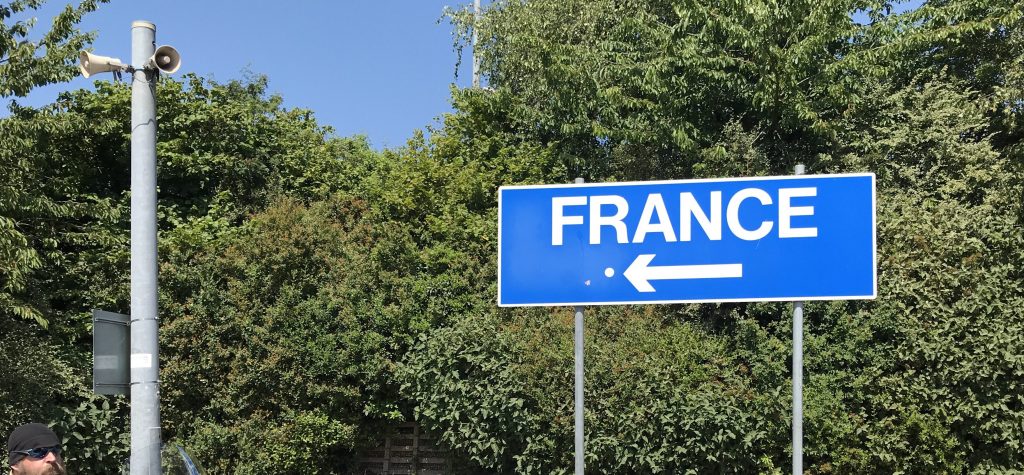
In the summer of 2018, a few months after buying our first campervan, we headed off on our first journey across the Channel as we embarked on a 3-month trip around Europe.
Europe is a wonderfully welcoming and diverse region waiting to be explored. More importantly, unlike some of the areas of the UK, campervans and motorhomes in Europe are positively welcomed, encouraged and well-catered for.
But for that first trip to Europe there are a myriad of things to think about, so it’s no surprise to see many people posting questions – both practical and technical – on forums and Facebook groups. Much of this is second nature to the experienced but the number of regular questions suggests not everyone has access to the information they need.
So to help beginners and those considering the that first trip abroad in your camper or motorhome I’ve tried to cover some of the stuff to think about and help you prepare, so check out the info below and be ready for your first trip.
Legal Requirements
Different countries have specific legal requirements on items you need to carry with you. A full list is available on various websites (such as the AA or RAC site) but the following list covers you for most of Europe:
- GB sticker – unless on your registration plate
- Yellow vests – one for each passenger (in passenger compartment)
- Warning triangle (two in Spain)
- Headlamp convertors
- First-aid kit
- Spare bulb kit
- Alcohol/breathalyser kit (France)
The above can be easily bought as a convenient kit like the AA one shown on the right for less than £25.
Also be aware of other country-specific restrictions, for example:-
- Spare prescription glasses are a legal requirement in certain countries (e.g. Spain)
- Driving in flip-flops is not recommended and illegal in certain countries
- Dashcams are illegal in certain countries
- Headlights or daylight running lights are compulsory in some countries (e.g. Norway requires headlights 24 hours a day)
What documents do I need to take
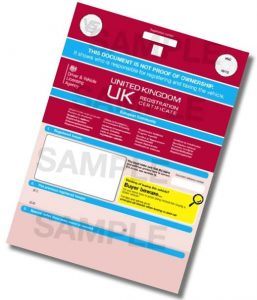 You need to take originals of the following documents. It’s also worth taking electronic copies – either take a photo or scan on your phone or save to email or a file-sharing service like Dropbox.
You need to take originals of the following documents. It’s also worth taking electronic copies – either take a photo or scan on your phone or save to email or a file-sharing service like Dropbox.
- Driving Licence
- V5 Registration Certificate
- Insurance certificate
- Green-card (your insurance company will provide)
- IDP International Driving Permit (check which one you need for the countries you are visiting, as there are different versions)
Also make sure your tax and MOT are up-to-date before you travel and won’t expire during your trip. Things may change with Brexit – check out the latest info on the Government website here.
Vehicle Breakdown Cover
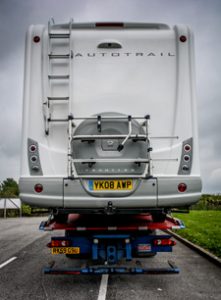 I’d recommend some kind of breakdown cover for peace of mind. Some insurance companies offer it as an add-on to your vehicle insurance. I pay £60 a year for European breakdown cover as an add-on to my Comfort Insurance. AA, RAC and Green Flag also offer euro breakdown cover (restrictions may apply if your vehicle is over a certain age).
I’d recommend some kind of breakdown cover for peace of mind. Some insurance companies offer it as an add-on to your vehicle insurance. I pay £60 a year for European breakdown cover as an add-on to my Comfort Insurance. AA, RAC and Green Flag also offer euro breakdown cover (restrictions may apply if your vehicle is over a certain age).
TIP – Make sure you declare your vehicle length when buying your cover and also in the event of a breakdown – you don’t want to wait hours for a truck to arrive to find it’s too small for your MH. And also mention if you have any pets with you.
Driving on the right
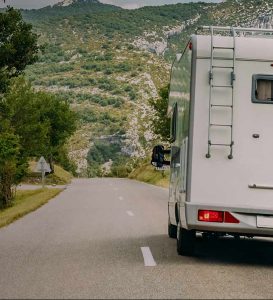 It’s really not as difficult or daunting as you may think – wthin a few miles you soon get used to it as you’re generally following other traffic. We found the first few minutes after an overnight stop and roundabouts to be the instances when you need to ensure your brain in engaged. Some people place a sticker at the bottom-right of their windscreen to remind them which side of the road they should be.
It’s really not as difficult or daunting as you may think – wthin a few miles you soon get used to it as you’re generally following other traffic. We found the first few minutes after an overnight stop and roundabouts to be the instances when you need to ensure your brain in engaged. Some people place a sticker at the bottom-right of their windscreen to remind them which side of the road they should be.
Driving a right-hand drive in Europe also makes overtaking more problematic as it’s harder to see ahead of the vehicle in front. Your passenger can be on look-out duties, but as you don’t tend to do much overtaking in a campervan/MH why not just take your time and relax.
Speed limits
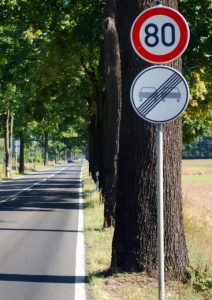 Make a note and be aware of different speed limits in each country and any specific differences for your size/weight of vehicle. Some limits also depend on the weather (e.g. rain) and though it seems obvious remember that speed limits signs in Europe are in kilometres per hour! Be aware, France seems particularly keen on sending speeding fines to the UK at the moment.
Make a note and be aware of different speed limits in each country and any specific differences for your size/weight of vehicle. Some limits also depend on the weather (e.g. rain) and though it seems obvious remember that speed limits signs in Europe are in kilometres per hour! Be aware, France seems particularly keen on sending speeding fines to the UK at the moment.
Also importantly, know your weight and size – particularly height and width (put a sticker on your dashboard) – and watch out for restriction signs for bridges and toll-booths.
Motorway Tolls & Vignettes
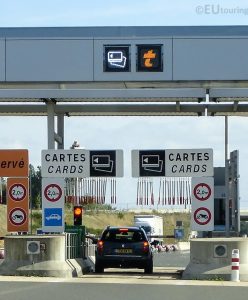 Some countries in Europe such as France and Spain have tolls on motorways. Charges can soon add up on longer journeys
Some countries in Europe such as France and Spain have tolls on motorways. Charges can soon add up on longer journeys
Other countries, including Austria, Bulgaria, Czech, Romania, Slovakia, Slovenia and Slovenia, require you to purchase and display a vignette/licence before you can use their motorway network. These can normally purchased at the border. In some countries, larger vehicles over 3.5t will need an electronic tag (e.g. Go Box in Austria).
For more details go to https://www.tolls.eu/europe
Clean-Air Restrictions
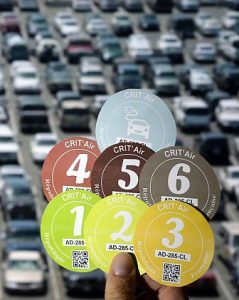 Check whether any cities you may be visiting have any ‘clean-air’ restriction that may restrict vehicles or require certificates to be displayed (e.g. French Crit-air sticker for Paris, Lyon, Grenoble, etc).
Check whether any cities you may be visiting have any ‘clean-air’ restriction that may restrict vehicles or require certificates to be displayed (e.g. French Crit-air sticker for Paris, Lyon, Grenoble, etc).
You can apply for French Crit-Air sticker here https://www.certificat-air.gouv.fr/en/. Your vehicle will be assigned a classification according to its type and emissions category (e.g. Euro5, Euro6), and which will define any limitations. E.g. some cities will allow only class 1-3 vehicles in the centre.
Money
 Using your normal bank card abroad can often come with admin charges and a poor exchange rate. It makes sense to use a card that minimises admin charges and gives you a better exchange rate when spending abroad. I use a Revolut account/card which offers great exchange rates with no charges and the accompanying app makes it easy to transfer money instantly and also offers a number of convenient security features.
Using your normal bank card abroad can often come with admin charges and a poor exchange rate. It makes sense to use a card that minimises admin charges and gives you a better exchange rate when spending abroad. I use a Revolut account/card which offers great exchange rates with no charges and the accompanying app makes it easy to transfer money instantly and also offers a number of convenient security features.
In northern Europe we found everywhere accepted card payment, however as we travelled south through the Alps more restaurants/cafes were inclined to ask for cash payment so keep some Euro notes handy.
TIP – when paying by card or withdrawing cash and the machine asks you to choose to pay in local currency or £’s, then always choose the local currency. This way you’ll use the exchange rate on your own card, rather than card machine rate which the poor rate the machine will apply.
Pets
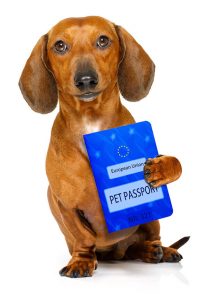 You’ll need a Pet Passport and appropriate injections – please seek advice from your local vet.
You’ll need a Pet Passport and appropriate injections – please seek advice from your local vet.
There are also rules to be followed when returning from Europe, requiring you to visit a vet to dispense a worming table (for your dog, not you!) and stamp their Pet Passport. You must then entering the UK between 1 day (minimum) and 5 days (maximum) afterwards – there is a pet check-in process at the ferry port or Eurotunnel terminal before you return.
Be conscious the nearer Calais you choose to visit a vet, the more expensive it’s likely to be. We paid equivalent of £6 in Poland, but in France it can be 30 to 40 Euros.
Pet travel regulations may change with Brexit, check out latest Government advice at gov.uk.
Water/Waste Service Points
Unlike the UK, most of Europe is well catered for in respect of service points to empty black/grey waste and top-up water. As well as campsites, most countries in Europe have approved places for campervan/MH overnight parking that include service points (e.g. aires in France, stellplatz in Germany).
Some service points are coin operated so keep some euro coins handy. In Norrway we found some super-duper machines into which you loaded your full toilet cassette which it auto-emptied and cleaned before returning it to you!
TIP – I recommend taking a variety of tap-connectors and a flexible hose to top-up your water tank (a watering can is a good but slow back-up).
Gas
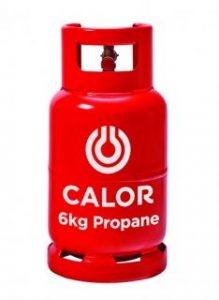 There is no universal connector or gas bottle across Europe, so when your Calor Gas bottle runs out you’ll need to pick up a new bottle and new regulator/connector in the country you’re in. This shouldn’t be difficult as they’re sold in most garages and supermarkets across Europe.
There is no universal connector or gas bottle across Europe, so when your Calor Gas bottle runs out you’ll need to pick up a new bottle and new regulator/connector in the country you’re in. This shouldn’t be difficult as they’re sold in most garages and supermarkets across Europe.
Another option for longer term travel is to fit a re-fillable LPG tank such as Gaslow. Though more expensive to fit (from around £250) filling up is cheaper and more convenient as you can fill-up via a pump at many garages.
From your UK travels you should have a feel for how long your gas will last from full. Our van uses gas only for cooking so we lasted over 10 weeks.
Security
Do your research – some spots in Europe are well know hot-spots for theft and break-ins. Sensible precautions include not leaving valuables on show, closing blinds and skylights, and if you have an alarm then use it.
Consider physical and visible security in the form of steering locks such as Disklok or Stoplock and additional locks. It may be worth fitting a hidden safe for valuables. We also use a ratchet strap between the doors, threaded through the steering wheel so any attempt at opening the door sounds the horn.
GPS trackers can be easily added for around £40 – see my separate post here.
Consider where you leave your van – if you don’t feel safe or comfortable in a location then move on.
Other Useful Gear
Over and above your usual gear for UK for trips to Europe you may also consider taking the following:-
|
Some euro sites use communal hook-up points rather than one per pitch, so you often will need a longer lead than in the UK |
Some sites will use a euro 2-pin socket so an adaptor is needed |
A tow-rope is handy for the friendly farmer to help when you’re stuck in a field or off-road |
A basic tool-kit may with temporary repairs. |
Navigation & Apps
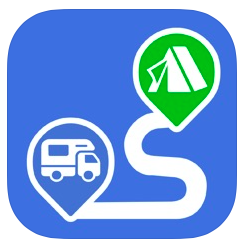 Some will meticulously plan and pre-book there trip whereas others will meander wherever they feel. There are a myriad of apps to help you find places for overnights stops, be they campsites, aires or more rural wild camp locations. Popular apps include Search4Sites, Campercontact, Park4Night. If you’re travelling out of the summer peak season it can be worth buying an ASCI card which includes a directory of associate sites which offer a discount
Some will meticulously plan and pre-book there trip whereas others will meander wherever they feel. There are a myriad of apps to help you find places for overnights stops, be they campsites, aires or more rural wild camp locations. Popular apps include Search4Sites, Campercontact, Park4Night. If you’re travelling out of the summer peak season it can be worth buying an ASCI card which includes a directory of associate sites which offer a discount
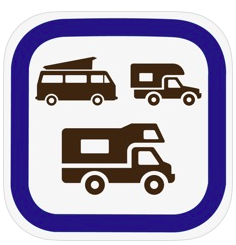 Some prefer dedicated sat-nav devices such as Garmin, Aguri etc. some of which allow you to add you vehicle dimensions to assist route planning. I use an iPad tablet with a large 10″ screen for navigation and running apps (it also doubles for watching TV/movies – see here).
Some prefer dedicated sat-nav devices such as Garmin, Aguri etc. some of which allow you to add you vehicle dimensions to assist route planning. I use an iPad tablet with a large 10″ screen for navigation and running apps (it also doubles for watching TV/movies – see here).
If you wish to track your route then the Polarsteps app makes it easy, auto-plotting your route, creating a journal and adding photos. See our Polasteps page here.
I do have the Copilot app installed for navigation but often just use Google Maps or in more remote areas I use the Maps.me app with pre-downloaded maps.
Mobile/Internet on the move
Unless you want to be limited to using campsite wifi (which we often found slow or intermittent, even when paid-for) then you’ll need to use mobile internet while you’re abroad.
You may be able to use your phone as a wifi hotspot but for more flexibility I’d recommend using a mi-fi type device, such as the Huawei 5577. A mifi device connects to the mobile network and then creates a local wifi network in your vehicle, so other phones and tablets devices can all connect to the internet.
If using your phone as a hotspot it’s worth checking your existing airtime contract for details on using data abroad. As well as potentially being expensive, some networks have restrictions or caps on data usage when roaming.
If you’re travelling full-time it’s worth seeking out a SIM-only monthly contract that includes plenty of data per month.
For shorter or ad-hoc trips abroad the pre-loaded Three SIM cards are good-value with 12Gb or 24Gb options. The data is valid for 12 months from the date you first use it.
Where to start
We jumped straight into a 3-month Europe trip, but a shorter trip over the Channel to France is a great place to start. France is well set-up for campervan/MH visitors with plenty of campsites and aires available. Pre-plan your route and overnight stops to reduce any stress or worry.
For those less confident, clubs such as The Camping and Caravan Club organise rally-type trips where you can travel a pre-arranged route with other MH’s (though not necessarily in convoy).
Be Flexible
Do be prepared to change/adjust even the best laid plans and accept that not everything will always go to plan. Bear in mind, the more planned you are, the more you may feel more pressured to keep to your plans, so try not to be too rigid.
Freedom and flexibility are one of the great benefits of campervan/motorhome travel so if you come across somewhere interesting or hear of a great place to visit then it’s easy to flex your plans.
We set off for our 3-month trip with only loose idea of a general loop though Europe, pre-booking only the ferry from Denmark to Norway – the rest of the trip simply evolved as we travelled, so we were never under pressure.
Enjoy!
Most importantly, remember to relax and enjoy yourself – heading over the Channel for the first time in your van/MH opens up a whole new world of travel and adventure. Once you’ve crossed the Channel for the first time you may never look back!
Excellent, some really useful information here, thank you. Planning our 1st European tour for next May in our Motorhome.
Thanks Brian – good luck with your first trip. Europe opens up so much more opportunity for travel and adventure.
Thank you this is so help full for us
Thanks Shona, glad it was of some help
Hi thinking of going to Poland was wanting to copy your route but can find it again
Hi Rachel, you can find our Poland route here
https://www.polarsteps.com/amountainhigh/1746614-poland